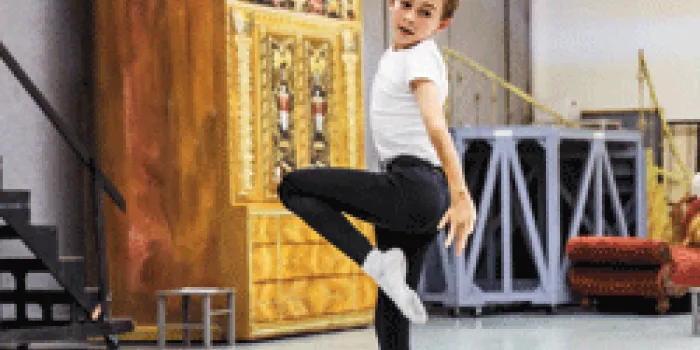In each issue of HemAware, we spotlight people in the bleeding disorders community. Here, we talk to Isaac Orrante, 11, from Columbus, Ohio, and his parents about his love for ballet.
To an audience, ballet dancers can appear weightless, almost floating across the stage. The truth behind that illusion is an intensely disciplined and rigorous art form that requires hours of training. Isaac Orrante, an 11-year-old from Columbus, Ohio, is no stranger to the demands of ballet. Although he has moderate hemophilia A, he has studied ballet since age 7. In December 2014, he played the role of Fritz in BalletMet Columbus’ production of The Nutcracker.
Ballet is a family affair for the Orrantes. Isaac’s father, Jimmy, is a company dancer with BalletMet, and his mother, Sonia, is a former dancer there and now teaches ballet. His two younger sisters, Imara and Aiyana, also take dance classes.
Watching his father backstage inspired Isaac to take dance classes as a child. At first, he only practiced once a week, but now he attends classes three times a week. When preparing for a production such as The Nutcracker—which he’s performed in with his father in the past—he rehearses five times a week. The schedule doesn’t bother Isaac. “I want to work my hardest to get better,” he says.
Sonia is continually impressed by her son’s affinity for ballet. “I know I’m biased,” she says with a laugh. “But he’s so in the moment. It’s uncanny to watch.” Isaac enjoys the applause from appreciative audiences, but that’s not his incentive. “He’s just so enamored with it,” she says.
All that training and passion has also affected Isaac’s bleeding disorder. Three years ago, the Orrantes were warned of a possible target joint developing in Isaac’s right knee. That was the year that Isaac started ballet classes. “I checked the infusion logs,” says Sonia. “After he began ballet lessons, everything got much better for managing his bleeding disorder.” She attributes the decline in Isaac’s bleeds to the flexibility and small muscle group control required by ballet.
Isaac plays soccer in addition to doing ballet, and he is determined not to let his bleeding disorder affect his physical activity. “Sometimes I get a big bruise from soccer and need to infuse, but I make sure I rest afterward,” he says.
At 11, Isaac isn’t required to do some of the more difficult positions and lifts that adult male dancers do. Sonia has some reservations about how long Isaac can dance while dealing with hemophilia. She sees ballet right now as a form of physical therapy for Isaac. However, once he grows older and his body matures, Sonia isn’t sure what will happen. “The training becomes pretty brutal,” she says. There are options, such as treating prophylactically, that might allow him to continue, but she’s taking a wait-and-see approach. “Most dancers live with some form of chronic injury,” Sonia says. Isaac is unconcerned with what might lie ahead. “I just think about what’s happening today and don’t worry about the future.”
But right now, Sonia and Isaac are happy with the role ballet plays in his life. Isaac will have a part in the BalletMet’s performance of The Great Gatsby in February, which will be choreographed by his father. Sonia is looking forward to a dance benefit that Jimmy and another dancer will do to benefit the Central Ohio Chapter of the National Hemophilia Foundation. And the entire Orrante family will continue to share their love of ballet as a family.

